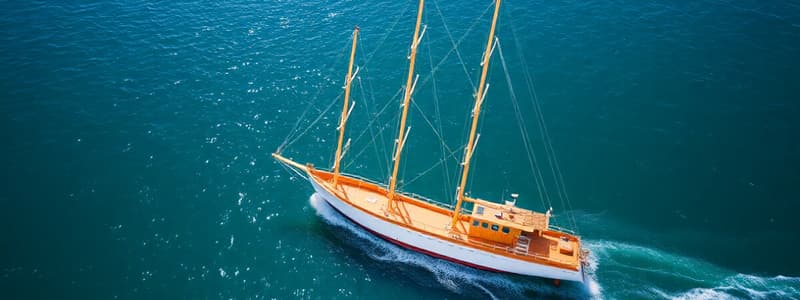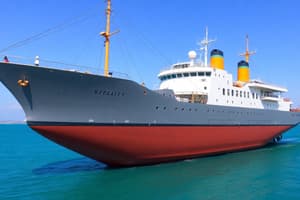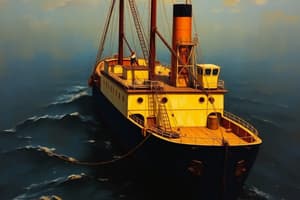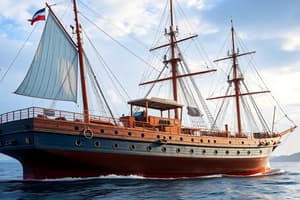Podcast
Questions and Answers
What condition defines a ship in stable equilibrium?
What condition defines a ship in stable equilibrium?
- The forces of weight and buoyancy are equal, but not necessarily opposite.
- The metacentric height (GM) is negative.
- The center of gravity (G) is above the center of buoyancy (B).
- The forces of buoyancy acting vertically upwards through the center of buoyancy (B) are equal and opposite to the weight of the ship acting vertically downwards through the center of gravity (G). (correct)
What does a 'tender' ship indicate about its metacentric height (GM) and rolling characteristics?
What does a 'tender' ship indicate about its metacentric height (GM) and rolling characteristics?
- Large GM, quick and uneasy roll.
- Large GM, slow and easy roll.
- Small GM, quick and uneasy roll.
- Small GM, slow and easy roll. (correct)
Under what condition is initial metacentric height (GM) considered negative, leading to unstable equilibrium?
Under what condition is initial metacentric height (GM) considered negative, leading to unstable equilibrium?
- When the transverse metacentre (M) coincides with the center of gravity (G).
- When the transverse metacentre (M) is below the center of gravity (G). (correct)
- When the transverse metacentre (M) is above the center of gravity (G).
- When the ship is subjected to external heeling forces.
What is the primary characteristic of a ship experiencing an angle of loll?
What is the primary characteristic of a ship experiencing an angle of loll?
Which action does NOT lower the center of gravity to correct an angle of loll?
Which action does NOT lower the center of gravity to correct an angle of loll?
What is the effect of free surface in a ship's tanks?
What is the effect of free surface in a ship's tanks?
What is the main purpose of baffle plates inside slack tanks?
What is the main purpose of baffle plates inside slack tanks?
How is the Righting Moment calculated?
How is the Righting Moment calculated?
What will happen if the transverse metacentre (M) and centre of gravity (G) coincide?
What will happen if the transverse metacentre (M) and centre of gravity (G) coincide?
How is KM determined during the initial construction of the ship?
How is KM determined during the initial construction of the ship?
Flashcards
Equilibrium
Equilibrium
When all forces are equal and the object is perfectly balanced, maintaining its center of gravity.
Stable Equilibrium
Stable Equilibrium
A ship can return to its original upright position after being heeled.
Metacentric Height (GM)
Metacentric Height (GM)
The vertical distance between the center of gravity (G) and the metacentre (M).
Righting Moment
Righting Moment
Signup and view all the flashcards
Tender Ship
Tender Ship
Signup and view all the flashcards
Unstable equilibrium
Unstable equilibrium
Signup and view all the flashcards
Neutral equilibrium
Neutral equilibrium
Signup and view all the flashcards
Angle of Loll
Angle of Loll
Signup and view all the flashcards
Free Surface
Free Surface
Signup and view all the flashcards
Capsizing Moment
Capsizing Moment
Signup and view all the flashcards
Study Notes
- Equilibrium describes an object at rest in its natural environment, where all acting forces are equal, maintaining its center of gravity (G).
- Ships experience three equilibrium states: stable, neutral, and unstable.
- A floating ship remains stationary and upright only when launched or in dry dock.
- Otherwise, it is considered in its natural state, floating in still or moving water.
- Archimedes' principle and the Law of Flotation apply for a ship to be in equilibrium.
- Stable equilibrium occurs when buoyancy forces act vertically upwards through the center of buoyancy (B).
- These buoyancy forces must equate and oppose the ship's weight, which acts downwards through the center of gravity (G).
- Vessels that meet these conditions float upright or roll around the vertical axis in a seaway, unless list or heel forces are present.
- Initial stable equilibrium relates to the vertical metacentric height (GM), and KM is determined via calculations and tests during construction, and is then tabled for use for varied load conditions.
- GM is positive when the metacentre (M) is above G along the centerline.
- Equilibrium is assessed with the ship heeled to small angles (10-15°) by external forces, as larger angles require detailed calculations guided by regulatory requirements.
- Stable equilibrium describes a ship's ability to return to its original upright position after being heeled at a small angle, once the heeling force is removed.
- In a heeled vessel, the center of gravity (G) remains constant, with the ship's weight acting downwards through G.
- The center of buoyancy (B) shifts in the direction of the heeling force, becoming B1.
- Buoyancy/upthrust acts vertically upwards through B1, intersecting the centerline at the transverse metacentre (M).
- Lever GZ, or the righting lever, acts with G as the fulcrum.
- The combined action attempts to correct the heel, returning the ship upright and is known as the Righting Moment or Transverse Moment of Statical Stability.
- The Righting Moment = W x GZ.
- GZ is linked to GM and the heel angle (Θ); G lying below M denotes a positive GM and vessel stability.
- A reasonably small metacentric height (GM) indicates a tender ship with a small righting lever at small angles, resulting in a slow roll.
- This condition may affect machinery due to unnecessary friction from pistons rubbing against liners during rolling.
- A large metacentric height (GM) results in a stiff ship that resists rolling, causing short rolling periods that can be uncomfortable and dangerous for personnel and cargo.
- In unstable equilibrium, the initial metacentric height GM is negative, or the transverse metacentre is below G.
- The lever (GZ) helps the heeling force, forcing the ship to an even larger heel angle, meaning the ship is unable to return to its original upright position.
- The lever GZ becomes a capsizing lever, contributing to a capsizing moment.
- When the transverse metacentre (M) and center of gravity (G) align, no lever is introduced, and no righting moment occurs, so the ship remains at the angle it adopts.
- This condition of neutral equilibrium means the ship is unstable if the center of gravity (G) rises, and more stable if it lowers.
- This is hazardous when fuel, water or other stores are used, or moving weights when initial GM is small, reducing the value to zero.
- A ship may become unstable when underway, even if initial equilibrium was stable, and may take up a list angle called the Angle of Loll, oscillating around this angle.
- Actions taken with a ship in this state starts with identifying whether the angle is due to list or loll.
- An angle of LIST occurs due to shifting weights across the centerline, whereas an angle of LOLL occurs when G moves vertically to coincide with M.
- The procedure to correct the loll angle prevents the ship from becoming unstable.
- To correct loll angle:
- Ballast or fuel may be transferred from the lowest point of the ship to the port centre.
- Fuel can be transferred from starboard wing tanks to the port centre if of the same grade.
- The GM may be gradually increased through ballasting once the loll angle is corrected.
Free Surface and Slack Tanks
- Free surface is the unrestricted movement of liquid on a ship's deck or in a partially filled tank.
- This increases ships rolling action due to liquid moving freely with the tanks.
- It introduces sloshing, increasing forces on structural members and moments above the center of gravity, causing violent rolling.
- Decks should allow water to flow away freely, and tanks are typically fitted with baffle plates to reduce this effect.
Studying That Suits You
Use AI to generate personalized quizzes and flashcards to suit your learning preferences.




